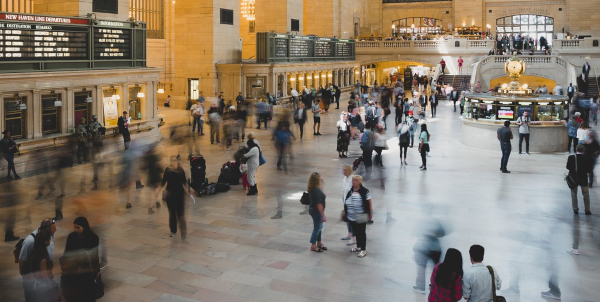Visitor flow
Contents |
[edit] Introduction
A visitor is a person (or sometimes another animal) that makes a visit, arriving at a place at which they are not usually resident or associated with, eg a visit to an aunt or a cinema. Their stay (the visit) is usually temporary but depending on circumstances may become permanent at which point they are no longer regarded as visitors. Tourists are usually classed as visitors.
Visitor flows describe the volume and movement of visitors to, and within, buildings and the spaces around and between them.
Measuring visitor flows helps assess how many people have used a space, and may also help anticipate or visualise trends and make future predictions. Knowing how people move through places, which entrances, exits and routes they use, what they stop to look at, which facilities they use and so on, are all vital to understanding how space is used, and how it should be designed to optimise the visitor experience.
Failing to properly design or manage visitor flow can lead to a disappointing visitor experience – and potential loss of revenue.
[edit] Managing visitor flows
Visitor flows can be low (few people relative to the venue), medium and high. Visitor flows must be managed so that crowds can be handled efficiently at peak times, while at off-peak times the venue does not overwhelm or intimidate the visitor.
Venues may wish to record, analyse and influence visitor flows for reasons of:
- Increasing their profitability.
- Optimising usage.
- Understanding how a facility is used by the public.
- Crowd control.
- Health and safety.
Tracking visitors is important if trends and patterns are to be discerned. This may be facilitated by on the one hand by manual observations or CCTV, or else collecting data from tracking devices. More advanced techniques include radio frequency identification (RFID) systems to log information about movement and dwell time in specific areas, or tracking mobile phones from visitors logged in to venue wifi networks.
A well-considered visitor management strategy should be the basis of effective site management: it will regulate how visitors access, view and move around the site. It may control visitor flow and cover aspects such as ticketing, opening and closing strategies, the use of barriers, signage, access for people with disabilities and so on. This
Problems that may be encountered include congestion at entrances, overcrowding at the interesting points, disorientation of visitors (especially if the site is complex or large) and poor access for the people with disabilities.
A visual representation of poor visitor flow can be seen in 'desire lines' which are the muddy tracks seen running across parks that are followed by visitors in preference to the designated routes becuse they take a more direct route to the desired destination.
Software is available to analyse existing visitor flows, and to predict visitor flows in new spaces. Space syntax is the process of studying '...the effects of spatial design on aspects of social, organisational and economic performance of buildings and urban areas.' Ref https://www.ucl.ac.uk/bartlett/architecture/research/space-syntax-laboratory
[edit] Websites
Visitor flow can also be used to describe how people arrive at and navigate around a website. For instance, they may ‘land’ on the home page or may enter via a topic that has been ‘Googled’. Or they may seek a specific sub-section of the site.
Website managers should know what the average dwell time on each part of a site is and whether users click on the adverts or are induced away from the site by external links. Considerations such as these can help companies maximise their revenue, offer visitors an optimised user experience and one that is more in tune with how they want to experience the site.
[edit] Related articles on Designing Buildings
Featured articles and news
RTPI leader to become new CIOB Chief Executive Officer
Dr Victoria Hills MRTPI, FICE to take over after Caroline Gumble’s departure.
Social and affordable housing, a long term plan for delivery
The “Delivering a Decade of Renewal for Social and Affordable Housing” strategy sets out future path.
A change to adoptive architecture
Effects of global weather warming on architectural detailing, material choice and human interaction.
The proposed publicly owned and backed subsidiary of Homes England, to facilitate new homes.
How big is the problem and what can we do to mitigate the effects?
Overheating guidance and tools for building designers
A number of cool guides to help with the heat.
The UK's Modern Industrial Strategy: A 10 year plan
Previous consultation criticism, current key elements and general support with some persisting reservations.
Building Safety Regulator reforms
New roles, new staff and a new fast track service pave the way for a single construction regulator.
Architectural Technologist CPDs and Communications
CIAT CPD… and how you can do it!
Cooling centres and cool spaces
Managing extreme heat in cities by directing the public to places for heat stress relief and water sources.
Winter gardens: A brief history and warm variations
Extending the season with glass in different forms and terms.
Restoring Great Yarmouth's Winter Gardens
Transforming one of the least sustainable constructions imaginable.
Construction Skills Mission Board launch sector drive
Newly formed government and industry collaboration set strategy for recruiting an additional 100,000 construction workers a year.
New Architects Code comes into effect in September 2025
ARB Architects Code of Conduct and Practice available with ongoing consultation regarding guidance.
Welsh Skills Body (Medr) launches ambitious plan
The new skills body brings together funding and regulation of tertiary education and research for the devolved nation.
Paul Gandy FCIOB announced as next CIOB President
Former Tilbury Douglas CEO takes helm.
UK Infrastructure: A 10 Year Strategy. In brief with reactions
With the National Infrastructure and Service Transformation Authority (NISTA).























